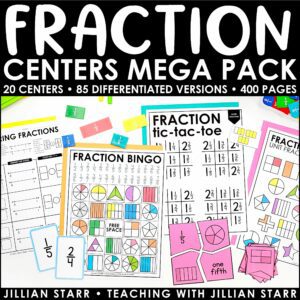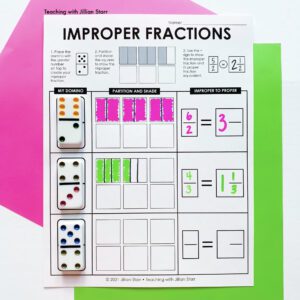

3D shapes, quite literally, make up the world around us. From ice cream cones to cans of beans to dressers in our bedrooms, 3D shapes are everywhere. Today, we’re going to talk about how to introduce, teach, and emphasize the importance of 3D shapes.
Talking the Talk of 3D Shapes
The “3D” in 3D shapes stands for three-dimensional. These shapes have three dimensions: length, width, and height. On the other hand, 2D or two-dimensional shapes are flat and only have a length and width. Because 3D shapes surround us, they are the perfect medium for creating engaging and hands-on learning experiences. But that’s not all! Using hands-on materials while doing this type of geometry work supports all students in understanding all the attributes of 3D shapes: edges, faces, and vertices.
Before we dive into the good stuff, let’s make sure we are speaking the same language with that geometry vocabulary. Faces are the flat or continuous surface of a shape, edges are where two faces meet, and vertices are the points where three or more edges meet.


For kindergarteners, informal language is perfect – they don’t need to master this terminology. As for first, second, and third graders, they will learn this vocabulary and use it to classify, analyze, and describe 3D shapes. They‘ll need to be able to identify which attributes make the shape the shape, like the number of faces, and which don’t, like its color. In other words, they’ll need to distinguish between defining attributes and non-defining attributes. Let’s dig into how to get this shape show on the road!


Rolling Out 3D Shapes
Well, they don’t all roll, but some do! My go-to way to introduce my students to 3D shapes is to (you guessed it!) get them in students’ hands. Regardless of the grade level, I want students to hold, explore, and manipulate 3D shapes from the get-go because they can learn so, so much – no formal instruction is needed (yet!).
Simply plunk down a basket of solid shapes out for students to look at, build with, sort, whatever! Now, I know that not all schools have enough (or any) 3D blocks. In my own experience, we always had to share with other classrooms and even still we didn’t have enough for the whole class. If that’s the case for you, that’s ok! Let the kids share and encourage that organic conversation about the shapes.
If you don’t have any 3D blocks, consider printing nets. Nets show what 3D shapes look like if they were unfolded and laid flat. Once you print these out, all you have to do is cut them out, fold them, and tape them together. You can prep them ahead of time or have students create them – another amazing hands-on activity!
Getting Things Sorted
In both kindergarten and first grade, we want students to be able to differentiate between different shapes: 2D and 3D as well as different types of 2D and 3D shapes. Shape and card sorts are perfect for building these skills.
To do a shape sort, all you need is, well, shapes! You can give kids 2D and 3D shapes (but make sure your 2D shapes are actually 2D!) and have them sort them however they want. An open sort like this allows students to practice using specific math vocabulary, explain their thinking, and learn from each other.
If you have specific content you want students to understand, have them sort the shapes in that way after the open sort. For example, if you give students a variety of shapes and students sort them by color or size or number of corners or whatever, but you want them to focus on 2D versus 3D, have them sort the shapes that way the second time they sort.
Actual shapes aren’t the only things that can be sorted though. You can easily make cards with images of 3D shapes or vocabulary words related to 3D shapes or both. Just write or draw what you want on index cards or even quickly draw them out on regular paper, make copies, and cut. This doesn’t need to be fancy at all because the magic is in the sorting and discussion, not in the cards themselves.
Just like with the shape sort, have students first sort them in any way that makes sense to them. Then guide them toward sorting the cards again to focus on whatever teaching point you are covering in that lesson. Some of my favorite teaching points for card sorts include the number of edges, the number of vertices, the number of faces, the shape of faces, and curved edges vs straight edges.
Shape Safari
Shape safari is just a fresh name for the old-school shape hunt. Kids have a blast with this one! In a shape safari, young mathematicians explore the classroom, school, playground, or just about anywhere! There are a bunch of ways to do this: give students a checklist with the names of shapes you want kids to look for, a checklist with images of the shapes, or just have them just search for any 3D shapes they see and record what they find. The possibilities (and fun!) are endless.
Mystery Shapes
Who doesn’t love a mystery? Mystery Shapes is a super fun game to play whole class or in pairs. One person chooses a 3D shape and hides it from everyone else. The rest of the players ask yes or no questions to get information about the shape. Using the answers, they have to guess the mystery shape.
In another version of the game, the person who picked the shape gives three clues. The rest of the players then have to use the three clues to guess the shape. This version makes the picker do the heavy math lifting while the first version puts the hard work on the guessers. Regardless of how you play, this game gets kids analyzing and describing 3D shapes.
Yet another twist on the mystery shape game is that kids practice composing larger shapes with 3D shapes. During this activity, one player uses 3D blocks to build a figure. The twist is that what they build is hidden from the rest of the players. Then, the builder uses positional words to describe their creation and the other players have to build the same thing. Once the construction is complete, the players reveal what they’ve built to see if they match.
Again, this game sharpens students’ skills in practicing identifying, composing, and describing 3D shapes. Plus, it’s just a ton of fun!
3D shapes are not only integral to our understanding of the world around us but also present endless opportunities for engaging and hands-on learning experiences in the classroom. By incorporating these activities, we can ensure that our students not only understand the attributes of 3D shapes but also develop an appreciation for their significance. So, let’s roll out the 3D shapes and embark on this exciting journey of exploration and discovery with our young mathematicians!










Leave a Comment